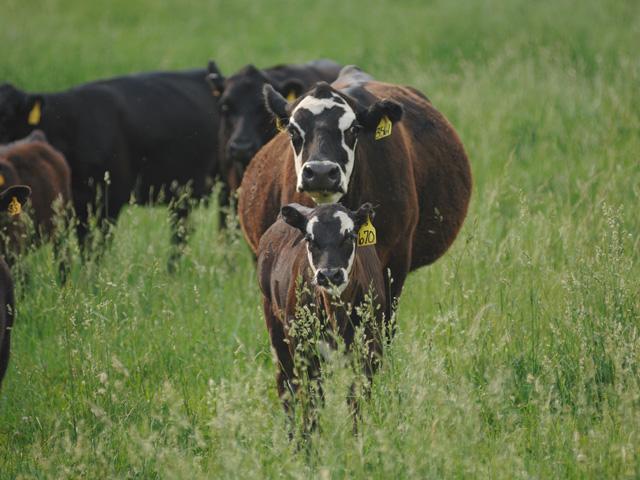Bullish Cattle Price Outlook Continues
Fewer Females Signal Ongoing Cattle Herd Contraction, Higher Prices
The U.S. beef herd continues to contract, with the latest numbers suggesting the bottom may come sometime in 2022, possibly even 2023.
USDA's midyear estimate showed inventory with the largest midyear decrease since 2012, down some 1.3% compared to July 2020. University of Kentucky livestock marketing specialist Kenny Burdine believes drought conditions in the West and Northern Plains played a big part in that estimate.
Burdine says, when looking to future herd size, keep your eyes on beef cow numbers. They are the key.
"Beef cow numbers were down about 2% from last year," he noted in an interview with DTN. One reason for that was beef cow slaughter, which was relatively high the first part of 2021.
Typically, Burdine said, most culling would occur in the fourth quarter as spring-born calves are weaned and operations decide whether to hold over a cow through the winter. The early drop, he said, is almost certainly tied to drought conditions. Through about mid-August, he reported over 180,000 more beef cows were slaughtered this year than last year.
Burdine added that we may see robust cow culling again in the fall, especially as many areas have remained under drought. Those producers, he said, won't likely have the ability to carry over large numbers of females through the winter without incurring significant input costs.
The other key component to future herd size is heifer retention. Burdine said this also points to a decrease in beef cow numbers as the industry moves toward 2022.
P[L1] D[0x0] M[300x250] OOP[F] ADUNIT[] T[]
"Beef heifer retention has been pretty flat the past three years," he said. "I like to examine that number as a percent of beef cow numbers. If heifer retention is smaller than the culling rate, that suggests decreases in beef cow inventory to me. Rates for retention have been around 1% below the average for the last three years, indicating producers are keeping herds tight. Weather and calf prices will further impact those patterns. I think if we add those together, culling and heifer retention, we are looking at maybe a 1.5% to 2% smaller cow herd next year."
All of this adds up to a bullish outlook on the price side.
"Looking ahead there is good reason for optimism," Burdine explained. "Fall CME feeder cattle futures were well into the $160s, which bodes well for our fall market. Inventory reports speak more to the longer-term outlook and the picture being painted there is relatively bullish. Decreases in inventory should line up with future increases in packing capacity. The two together are significant reasons for optimism for the next few years."
RABOBANK REPORT SHOWS U.S. LATE TO THE PARTY
The just-released Rabobank Beef Quarterly report also has bullish news for the U.S. cattle industry. The update, by lead author Angus Gidley-Baird, noted a price outlook for fed cattle for the fourth quarter and into 2022, better than what the U.S. has seen the past several years. It shows current fed steer prices 25% above last year and 8% above the five-year average.
Don Close, veteran cattle market analyst and a senior animal protein analyst with Rabo AgriFinance, said that looking at this report, it's clear the trend toward strong cattle prices is global in nature. He says the U.S. is one of the last to the party.
"We have been so distracted and even blindsided because of the leverage imbalance issue that has caused economic stress on our fed cattle prices, that we haven't really observed what is going on in the rest of the world. I think, for the U.S., our turn is coming," he told DTN.
The wild card, noted Close, continues to be drought conditions in the Northern Plains and the West.
"What happens here over the next few weeks we don't know. We could see enough liquidation due to weather events to expedite this whole process of herd contraction by as much as six months to a year. But we're not there yet. Our view, at this time, is we are going to see a net liquidation of cows through 2022 and maybe even into 2023."
Asked if this means replacement heifer values will catch fire this year, Close said he thinks it's a little early yet for that. Higher replacement prices will hit when the trend turns toward expansion, not liquidation.
"You're not the first call I've had with that question, though," he said. "We are getting reports of pairs in Montana and Wyoming selling for around $1,400. When you can buy a good pair for that, it probably isn't going to make economic sense to develop heifers right now."
On the cow side, however, Close said there may be an opportunity, where forage and feed is not an issue, to hold open cows and sell them as bred. Consider the cost to carry, and if the numbers work, this is a strategy that may have some positive returns moving forward.
Victoria Myers can be reached at vicki.myers@dtn.com
Follow her on Twitter @myersPF
(c) Copyright 2021 DTN, LLC. All rights reserved.






